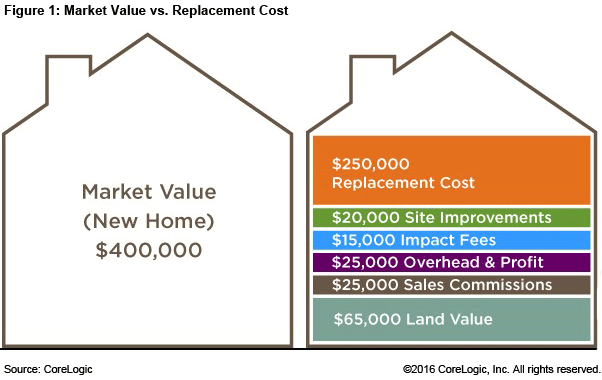Updated May 1, 2024
Differences between determining a property’s value and accurately estimating its replacement cost are worth comparing
The market value and replacement cost of a building are not the same thing.
They are distinctly different concepts that are estimated using different criteria. It is not necessary that the market value and replacement cost of a building are identical, as the two are distinctly different approaches to valuing a property using real estate data analytics.

So what is replacement cost and what is market value?
Market value is the estimated price at which a property would be sold on the open market between a willing buyer and seller under all conditions for a fair sale. Replacement cost is the estimated cost to construct, at current prices, a property worth the amount of the property being appraised.
When comparing market value to replacement cost, it is important to understand what both represent and what factors are considered in each circumstance. Otherwise, a meaningful comparison cannot be made.
Defining Market Value vs. Replacement Cost
Market Value
This represents the agreement between the buyer and the seller of how much a property is worth. In real estate data analytics, it often includes:
- Value of land
- Site improvements to the land
- The building
- Sometimes personal property and intangible assets
To compare market value to replacement cost, adjustments must be made for such factors.
Replacement Cost
This is the price to construct or replace an entire building of equal quality and utility, using current prices for labor, materials, overhead, profit, and fees at the time of the appraisal.
The construction or replacement of the building uses modern materials and current methods, designs, and layouts. Replacement cost does not account for improvements necessary to conform to building codes, demolition, debris removal, site accessibility, reuse of building components or services, overtime, bonuses for labor, abnormal soft costs, extraordinary fees, premiums for materials, and various other contingencies.
In addition to material and labor costs, CoreLogic cost data includes: consideration of permits, surveys, builder risk insurance, sales taxes, built-ins, and other costs that would typically be paid for by a consumer in a particular market, for example, an electrical or plumbing allowance.
Unless specifically added to your cost estimate, the CoreLogic costs do not include real estate commissions, land, landscaping, sidewalks, driveways, patios, well and septic systems, sewer and water systems, and other land improvements.
Factors that Impact Market Value Vs. Replacement Cost
Although the concepts of market value and reconstruction cost are different, both are affected by economic conditions.
The supply and demand for housing also impacts the fair market value, just as the supply and demand for labor and materials affect replacement cost. When situations arise where supply does not match or equal demand, market value and the replacement cost can change quickly. CoreLogic continually monitors changing market conditions throughout the U.S. and Canada and makes appropriate adjustments for these situations when necessary.
It is important to note that the fair market value and replacement cost for a building may not be the same because they are different concepts. Market value is in the eye of buyers and sellers, while replacement cost is the sum of all elements brought together to produce a physical property. In the example above, we have made the two total valuations identical, which is the ideal. Overhead and profit component are just two variables that can change the total cost approach valuation.
CoreLogic’s Marshall & Swift solution taps our extensive library of property data to help clients best determine accurate property values and evaluate construction costs. For more than 90 years, appraisers, government agencies, lenders, and tax servicers have turned to Marshall & Swift to enable them to make the smartest business decisions.
The CoreLogic statements and information in this blog post may not be reproduced or used in any form without express written permission. While all the CoreLogic statements and information are believed to be accurate, CoreLogic makes no representation or warranty as to the completeness or accuracy of the statements and information and assumes no responsibility whatsoever for the information and statements or any reliance thereon. CoreLogic® and Marshall & Swift® are the registered trademarks of CoreLogic, Inc. and/or its subsidiaries.


